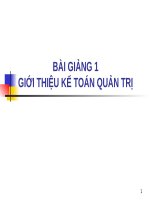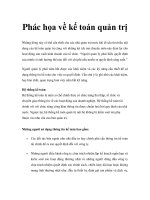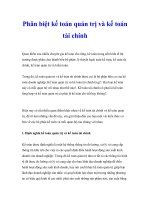ch12 Planning for Capital Investments Ke toan quan tri
Bạn đang xem bản rút gọn của tài liệu. Xem và tải ngay bản đầy đủ của tài liệu tại đây (1.52 MB, 62 trang )
Page
12-1
Planning for Capital
Investments
Managerial Accounting
Fifth Edition
Weygandt Kimmel Kieso
Page
12-2
study objectives
1.
Discuss capital budgeting evaluation, and explain inputs
used in capital budgeting.
2.
Describe the cash payback technique.
3.
Explain the net present value method.
4.
Identify the challenges presented by intangible benefits in
capital budgeting.
5.
Describe the profitability index.
6.
Indicate the benefits of performing a post-audit.
7.
Explain the internal rate of return method.
8.
Describe the annual rate of return method.
Page
12-3
preview of chapter 12
Page
12-4
The
The Capital
Capital Budgeting
Budgeting Evaluation
Evaluation
Process
Process
Corporate capital budget authorization process:
1.
Proposals for projects are requested from each
department.
2.
Proposals are screened by a capital budget
committee.
3.
Officers determine which projects are worthy of
funding.
4.
Page
12-5
Board of directors approves capital budget.
SO 1 Discuss capital budgeting evaluation,
and explain inputs used in capital
Page
12-6
The
The Capital
Capital Budgeting
Budgeting Evaluation
Evaluation
Process
Process
Cash Flow Information
For purposes of capital budgeting, estimated
cash inflows and outflows are the preferred
inputs.
Why?
Ultimately, the value of all financial investments
is determined by the value of cash flows
received and paid.
Page
12-7
SO 1 Discuss capital budgeting evaluation,
and explain inputs used in capital
The
The Capital
Capital Budgeting
Budgeting Evaluation
Evaluation
Process
Process
Cash Flow Information
Illustration 12-2
Typical cash flows relating
to capital budgeting
decisions
Page
12-8
SO 1 Discuss capital budgeting evaluation,
and explain inputs used in capital
The
The Capital
Capital Budgeting
Budgeting Evaluation
Evaluation
Process
Process
Cash Flow Information
The capital budgeting decision depends on:
Page
12-9
1.
The availability of funds.
2.
Relationships among proposed projects.
3.
The company’s basic decision-making
approach.
4.
The risk associated with a particular project.
SO 1 Discuss capital budgeting evaluation
process, and explain inputs used in
The
The Capital
Capital Budgeting
Budgeting Evaluation
Evaluation
Process
Process
Illustrative Data
Stewart Soup Company is considering an investment
of $130,000 in new equipment.
Illustration 12-3
Page
12-10
SO 1 Discuss capital budgeting evaluation
process, and explain inputs used in
Cash
Cash Payback
Payback
The cash payback technique identifies the time
period required to recover the cost of the capital
investment from the net annual cash inflow
produced by the investment.
Illustration 12-4
The cash payback period for Stewart Soup is …
$130,000 / $24,000 = 5.42 years
Page
12-11
Solution on
notes page
SO 2 Describe the cash payback technique.
Cash
Cash Payback
Payback
The shorter the payback period, the more
attractive the investment.
In the case of uneven net annual cash flows, the
company determines the cash payback period
when the cumulative net cash flows from the
investment equal the cost of the investment.
Page
12-12
SO 2 Describe the cash payback technique.
Cash
Cash Payback
Payback
Illustration: Chen Company proposes an
investment in a new website that is estimated to
cost $300,000.
Illustration 12-5
Cash payback should not be the only basis for the capital
budgeting decision as it ignores the expected profitability of the
project.
Page
12-13
Solution on
notes page
SO 2 Describe the cash payback technique.
Cash
Cash Payback
Payback
KRC Paper Corporation is considering adding
another machine for the manufacture of
corrugated cardboard. The machine would cost $900,000. It
would have an estimated life of 6 years and no salvage value.
The company estimates that annual cash inflows would
increase by $400,000 and that annual cash outflows would
increase by $190,000. Compute the cash payback period.
Page
12-14
Solution on
notes page
SO 2 Describe the cash payback technique.
Cash
Cash Payback
Payback
Question
A $100,000 investment with a zero scrap value
has an 8-year life. Compute the payback period
if straight-line depreciation is used and net
income is determined to be $20,000.
Page
12-15
a.
8.00 years.
b.
3.08 years.
c.
5.00 years.
d.
13.33 years.
Solution on
notes page
SO 2 Describe the cash payback technique.
Net
Net Present
Present Value
Value Method
Method
Discounted cash flow technique:
Generally recognized as the best approach.
Considers both the estimated total cash
inflows and the time value of money.
Two methods:
Page
12-16
Net present value.
Internal rate of return.
SO 3 Explain the net present value method.
Net
Net Present
Present Value
Value Method
Method
Net Present Value (NPV) method
Cash inflows are discounted to their present
value and then compared with the capital outlay
required by the investment.
The interest rate used in discounting is the
required minimum rate of return.
Proposal is acceptable when NPV is zero or
positive.
Page
12-17
The higher the positive NPV, the more
attractive the investment.
SO 3 Explain the net present value method.
Net
Net Present
Present Value
Value Method
Method
A proposal is
acceptable when
net present value is
zero or positive.
Page
12-18
Illustration 12-6
Net present value decision
criteria
SO 3 Explain the net present value method.
Net
Net Present
Present Value
Value Method
Method
Equal Annual Cash Flows
Illustration: Stewart Soup Company’s annual cash
flows are $24,000. If we assume this amount is
uniform over the asset’s useful life, we can
compute the present value of the net annual cash
flows.
Page
12-19
Illustration 12-7
SO 3 Explain the net present value method.
Net
Net Present
Present Value
Value Method
Method
Equal Annual Cash Flows
Illustration: Calculate the net present value.
Illustration 12-8
The proposed capital expenditure is acceptable at a
required rate of return of 12% because the net present
value is positive.
Page
12-20
Solution on
notes pageSO
3 Explain the net present value method.
Net
Net Present
Present Value
Value Method
Method
Unequal Annual Cash Flows
Illustration: Stewart Soup Company expects the
same total net cash flows of $240,000 over the life of
the investment. Because of a declining market
demand for the new product the net annual cash
flows are higher in the early years and lower in the
later years.
Page
12-21
SO 3 Explain the net present value method.
Net
Net Present
Present Value
Value Method
Method
Unequal Annual Cash Flows
Page
12-22
Illustration 12-9
Computation of present value
of unequal annual cash flows
SO 3 Explain the net present value method.
Net
Net Present
Present Value
Value Method
Method
Unequal Annual Cash Flows
Illustration: Calculate the net present value.
Illustration 12-10
The proposed capital expenditure is acceptable at a
required rate of return of 12% because the net present
value is positive.
Page
12-23
SO 3 Explain the net present value method.
Net
Net Present
Present Value
Value Method
Method
Choosing a Discount Rate
In most instances a company uses a required rate of
return equal to its cost of capital — that is, the rate
that it must pay to obtain funds from creditors and
stockholders.
Discount rate has two elements:
Page
12-24
Cost of capital.
Risk.
Rate also know as
required rate of return.
hurdle rate.
cutoff rate.
SO 3 Explain the net present value method.
Net
Net Present
Present Value
Value Method
Method
Choosing a Discount Rate
Illustration: Stewart Soup used a discount rate of
12%. Suppose this rate does not take into account the
risk of the project. A more appropriate rate might be
15%.
Page
12-25
Illustration 12-11
SO 3 Explain the net present value method.









